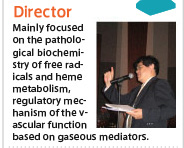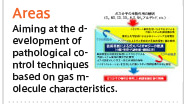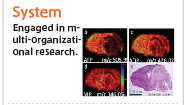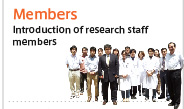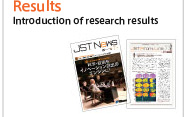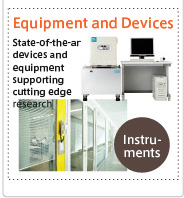ERATO International |
Makoto Suematsu
Research Director |
- Applied to Medicine to elucidate the biological effects
of gas molecules in vivo
- Dean and Professor of School of Medicine, Keio University
- Research Director Makoto Suematsu
|
【Introduction】
Our lives are sustained through the utilization the bio-energy generated by carbohydrates and oxygen reacting by the metabolic system; at the same time, this process serves as a warning system against stimuli from the outside world. NO, CO, H2S are well-known as low-molecular weight gas mediators that are generated from the end of the metabolic system; these gas molecules may work as an important control factor over the metabolic system by regulating the functions of proteins that possess a metallic center such as enzymes. The significant dependency of the redox state of the metallic center on the bonding state of gases however, has rendered the understanding of gas molecule behavior in the body extremely difficult, and likewise the identification of receptors, or functional assessment, thus relegating the clarification of the complete picture, or its potential application to the control of pathological conditions to an unknown area. Molecular biology, biochemistry, computer science, physics and others should be included to organize an interdisciplinary research team integral to solving such challenges, together with the application of state-of-the-art measurement science.
The Suematsu Gas Biology Project will promote a project aiming for comprehensive explanation of the acceptance, transportation, and decomposition mechanisms of the gas molecules produced and utilized in the body and applying the results to Medicine.

Gregg L. Semenza
Research Director |
-
- Professor, Johns Hopkins University
- Director, Program in Vascular Cell Engineering - Institute for Cell Engineering
- Gregg L. Semenza
|



| March, 1983 |
Graduated from the School of Medicine, Keio University |
| April, 1984 |
Entered the Graduate School of Medicine, Keio University (majored in Internal Medicine) |
| March, 1988 |
Left the Graduate School of Medicine, Keio University with required courses completed |
| April, 1988 |
Assistant at Keio University (Department of Internal Medicine, School of Medicine) |
| January, 1990 |
Assistant at Keio University (Central Clinical Examination Department, School of Medicine) |
| May, 1991 |
Assistant at Keio University (Department of Internal Medicine, School of Medicine)
After return to the department, immediately went to the Institute for Biomedical Engineering, University of California, San Diego (Supervised by Professor Benjamin W. Zweifach). |
| April, 1996 |
Assistant Professor of Keio University (Department of Biochemistry and Integrative Medical Biology, School of Medicine) |
| April, 2001 |
Professor of Keio University (Department of Biochemistry and Integrative Medical Biology, School of Medicine) |
| October, 2002 |
Project operator for hub formation in 21st Century COE Life Science "Understanding and Management of Life Function through System Biology" |
January, 2003
 |
Professor of Environment and Information Studies of Keio University (interlocking) |
| April, 2003 |
Representative researcher, the Leading Project for Biosimulation by the Ministry of Education, Culture, Sports, Science and Technology of Japan |
| June, 2005 |
Member of Committee of Life Science, Ministry of Education, Culture, Sports, Science and Technology of Japan
Steering committee Research and Development of Integrated Simulation Software for Next Generation Life Form, RIKEN
Base representative for Bases of In vivo Human Metabolic Systems Biology by the Ministry of Education, Culture, Sports, Science and Technology of Japan COE for Life Science
Head, Center for Human Metabolic Systems Biology
|
| October, 2007 |
Dean, School of Medicine, Keio University
 |

| 1984 to present |
Japanese Society for Microcirculation (Director) |
| 1984 to present |
The Japanese Society of Gastroenterology |
| 1988 to present |
The European Microcirculatory Society |
| 1989 to present |
The Microcirculatory Society USA |
| 1991 to present |
The Oxygen Societ |
| 1992 to present |
The Japanese Biochemical Society (Councilor, Chief of Kanto Branch) |
| 1994 to present |
American Association for the Study of Liver Diseases |
| 1995 to present |
The Society of Blood Substitutes, Japan (Director) |
2001 to present
 |
American Society for Biochemistry and Molecular Biology and more,
including editorial committee of English journals (Am J Physiol, Antioxid Redox Signal, etc.)
 |

| 1990 |
Young Investigator's Award from The 14th Microcirculatory Society, Europe |
| 1990 |
Incentive Award from the 30th Science and Technology Film Festival |
| 1992 |
Certificate of Appreciation from Mexican Society of Anesthesiologists (for the research of free radical bioimaging) |
| 1994 |
Lafon Microcirculatory Award from the 16th European Microcirculatory Society Conference |
2004
 |
American Physiology Society/The Microcirculatory Society 50th Anniversary
Selected as Historical Poster (Free Radical Bioimaging in Microcirculation)
 |
2010
 |
Society for Free Radical Research JAPAN
 |


| 1984 |
Completed the doctoral course (medicine, genetics), University of Pennsylvania |
| 1986 |
Resident (pediatrics), Duke University Medical Center |
| 1990 |
Post-doctoral fellow, Johns Hopkins University (clinical genetics) |
| 1994 to 1999 |
Associate professor, Johns Hopkins University (pediatrics)) |
| 1999 |
Professor, Genetics and Medical Institute, Johns Hopkins University |
2003 to present
 |
rofessor, Johns Hopkins University (pediatrics)
Director of Vascular Cell Engineering Program, Institute for Cell Engineering, Johns Hopkins University
 |



























